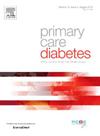新治疗的成人2型糖尿病患者新发抑郁发作的发生率和相关因素:一项队列研究
IF 2.6
4区 医学
Q3 ENDOCRINOLOGY & METABOLISM
引用次数: 0
摘要
目的:有几种方法可以帮助识别抑郁症患者;然而,关于何时开始筛查的指导很少。本研究估计了新治疗的2型糖尿病成人患者新发抑郁发作的发生率,并确定了与发病相关的因素。方法:采用加拿大艾伯塔省的行政卫生数据,确定2011年4月至2015年3月期间开始使用二甲双胍的人群。在开始使用二甲双胍之前有抑郁史的人被排除在外。根据性别、年龄和年份,采用人-时间分析计算未来3年内新发抑郁发作的发生率。使用多变量逻辑回归来确定与新抑郁发作独立相关的因素。结果:42,694名成人开始使用二甲双胍;平均年龄56岁,38% %女性。2752人(6 %)出现新的抑郁发作,平均发病时间为1.4年,总发病率为22.3/1000人年。与新发抑郁发作相关的因素为女性、年龄较小、既往精神健康状况、频繁的医疗保健利用和多种合并症。结论:抑郁症筛查应在开始服用二甲双胍1-2年内开始,并以女性为重点本文章由计算机程序翻译,如有差异,请以英文原文为准。
Incidence and factors associated with new depressive episodes in adults with newly treated type 2 diabetes: A cohort study
Aims
Several methods are available to help identify people with depression; however, there is little guidance on when to start screening. This study estimated the incidence of new depressive episodes and identified factors associated with onset in adults with newly treated type 2 diabetes.
Methods
Administrative health data from Alberta, Canada was used to identify people starting metformin between April 2011 and March 2015. People with a history of depression before metformin initiation were excluded. Person-time analysis was used to calculate the incidence rate of new depressive episodes over the next 3 years, stratified by sex, age, and year. Multivariable logistic regression was used to identify factors independently associated with a new depressive episode.
Results
42,694 adults initiated metformin; mean age 56 years, 38 % female. A new depressive episode occurred in 2752 (6 %) individuals, mean time to onset was 1.4 years and overall incidence rate was 22.3/1000 person-years. Factors associated with a new depressive episode were female sex, younger age, previous mental health conditions, frequent healthcare utilization, and multiple comorbid conditions.
Conclusions
Screening for depression should begin within 1–2 years of metformin initiation and focus on females, those < 55 years old, those with a history of mental health conditions, and those with multiple comorbid conditions.
求助全文
通过发布文献求助,成功后即可免费获取论文全文。
去求助
来源期刊

Primary Care Diabetes
ENDOCRINOLOGY & METABOLISM-PRIMARY HEALTH CARE
CiteScore
5.00
自引率
3.40%
发文量
134
审稿时长
47 days
期刊介绍:
The journal publishes original research articles and high quality reviews in the fields of clinical care, diabetes education, nutrition, health services, psychosocial research and epidemiology and other areas as far as is relevant for diabetology in a primary-care setting. The purpose of the journal is to encourage interdisciplinary research and discussion between all those who are involved in primary diabetes care on an international level. The Journal also publishes news and articles concerning the policies and activities of Primary Care Diabetes Europe and reflects the society''s aim of improving the care for people with diabetes mellitus within the primary-care setting.
 求助内容:
求助内容: 应助结果提醒方式:
应助结果提醒方式:


